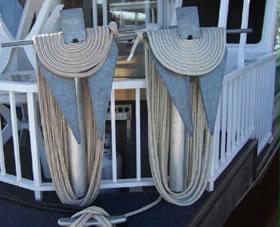Houseboat Safety Systems
Antelope Point Marina Houseboats
Your Antelope Point Marina Houseboat comes equipped with several safety systems and includes safety equipment for your use. When you take charge of your new watercraft, it is important to become familiar with the on-board systems and equipment, understand their proper use, and the location of all equipment on board your vessel. Your houseboat instructor will review each of these items and systems with you thoroughly allowing time for any questions you may have.
Some on-board safety systems are fully automatic. These include your carbon monoxide and smoke detectors, the bilge fire suppression system, and the gas fume/vapor detectors. Other safety equipment requires use by you and/or your crew. These include the fire extinguishers, and the personal flotation devices (PFD’s or more commonly known as life jackets) that are provided. If you are unfamiliar with any safety equipment on board, your houseboat instructor will make sure you are comfortable with its operation and use prior to your departure from the marina.
When you arrive at the marina for your houseboat orientation, a qualified and experienced Houseboat Instructor will review all safety equipment and systems with you. Most “Captains” find it helpful to assign one or two more “Mates” to take part in this important orientation.

Houseboat Safety Equipment & Systems:
- Fire Extinguishers
- Marine Band Radio
- Global Positioning System (GPS)
- Throw Rings & Orange SOS Flag
- First Aid Kit
- 12v Electric Bilge Pumps
- Gasoline Fume Detector
- Automatic Engine Compartment Fire Supression System
- Anchors & Ropes (appropriate to your houseboat type)
Smoke Detectors
Your houseboat will be equipped with multiple smoke detectors throughout. You will test and review the location of your smoke detectors during your houseboat tour prior to departure from the marina.
Carbon Monoxide (CO) Detectors
Smoke detectors are installed in all cabins, hallways, and living areas of your houseboat. Detectors are extremely sensitive to even minimal levels of CO and will beep and flash to alert you to the presence of CO so that you can take the appropriate action.
CO Detectors play an important role in houseboating safety: Carbon monoxide is colorless, odorless, tasteless, and mixes evenly with air. It enters your blood stream through the lungs and displaces the oxygen that your body needs. Early symptoms of carbon monoxide poisoning include: irritated eyes, headache, nausea, weakness, and dizziness. These symptoms are often confused with seasickness or too much sun. Prolonged exposure can lead to serious illness or death so it is important to know when to take action.
Carbon monoxide can collect inside of any type of boat in a variety of ways. Poorly vented exhaust can re-enter a boat if it is moored too close to another boat, or if the exhaust is pushed back by prevailing winds. Exhaust can also re-enter through open windows and collect in still areas.
On your houseboat, carbon monoxide from your generator(s) is vented upwards through the “stacks” on the top deck to prevent a build-up around the back deck area. However, there is still a possibility that carbon monoxide could stay near the boat, particularly in very calm weather conditions, and become a hazard.
Marine Band Radio
A marine band radio is included on all houseboats and most power boats. Your marine band radio is your primary source of communication with marina facilities and services while on the lake. All marinas and the local authorities (NPS, Coast Guard or US Forest Service) monitor Channel 16.
When communicating on the radio, general protocol requires that you establish contact on Channel 16 and then switch to a mutually agreed upon channel for further communication. If your communication is an emergency, then you will stay on Channel 16. Your radio may also have a “WX” button which will give you weather information from the National Weather Service. Switch to channel “WX 1” to check updated weather conditions.
If you’re new to marine radio use, it can seem a little intimidating in the beginning. Your Houseboat Instructor will demonstrate how to use your radio as part of your check out procedure. Go ahead and try out the radio – you will soon be comfortable with the proper use of this very helpful and important tool for lake-wide communication.

Automatic Engine Compartment Fire Suppression System
Your houseboat is equipped with an automatically activated Temperature Sensor Valve on a specially designed fire extinguisher installed in the engine compartment(s). This valve is designed to discharge when the sensor reaches a certain activation point. The suppression system is monitored at the helm and a green indicator light illuminates while underway to indicate the system is active. Your Houseboat Instructor will review this system with you during check-out.
Anchors and Ropes
Houseboats are required to be beached and properly anchored or staked by nightfall on all lakes. Your houseboat is equipped with ample anchors and high-quality marine ropes – able to secure even the largest vessel when properly deployed.
For a more complete review of how to anchor your houseboat, read the Anchoring or Staking Your Houseboat topic in the Houseboating 101 series.

